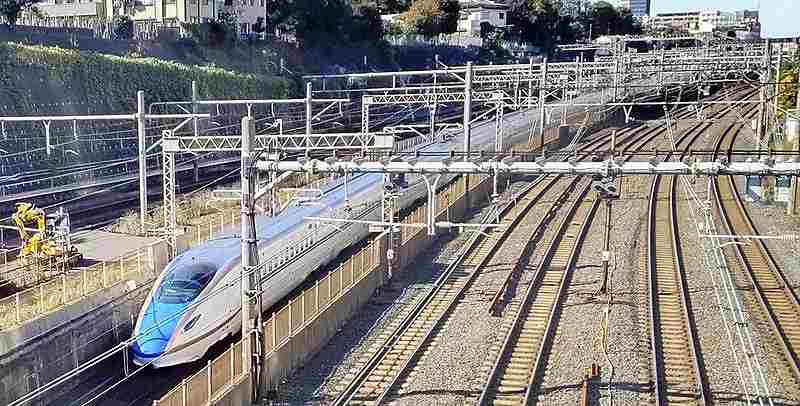
A JR East Shinkansen train travels through Arakawa Ward in Tokyo.
November 22, 2021
The cost of travel is set to change next spring, with transport operators looking at raising ticket prices to increase revenue or overhauling fare structures to reduce costs.
Travelers are likely to face increased prices as transportation firms hit hard by the COVID-19 pandemic look to spread the burden.
East Japan Railway Co. (JR East) is raising the price of Green Car (first-class) tickets on the Tohoku and Joetsu Shinkansen lines by about 30% from next spring.
The prices were lowered in 2002 in an attempt to get more people using the services, but from next year they will be the same level as fares on the Tokaido and Sanyo Shinkansen lines.
For example, to use a Green Car between Tokyo and Fukushima stations on the Tohoku Shinkansen line, it costs an extra ¥3,150. From next spring, it will be more expensive to ¥4,190.
The price hikes could increase revenues by up to several billion yen per year.
Other railway companies are also considering raising prices.
Tokyu Railways Co. will increase its lowest adult fare from ¥130 to ¥140 in 2023.
Excluding price adjustments that coincided with changes to consumption tax, it will be the first time private railway firms in the Tokyo metropolitan area have raised fares since 1995 when all of the operators hiked prices at the same time.
Kintetsu Railway Co. has also indicated it will raise fare prices.
On the other hand, Odakyu Electric Railway Co. plans to introduce a ¥50 flat fare for elementary school students from next spring. Currently, tickets for elementary school students are half the price of an adult ticket.
The company hopes to prevent a decline in the number of passengers by attracting families, while also creating a child-friendly image.
Overcrowding
Transport firms have also been revising fare structures to reduce crowding.
JR East, West Japan Railway Co. (JR West) and Hokkaido Railway Co. (JR Hokkaido) will introduce a new peak ticket tier next spring for reserved seats on Shinkansen trains, excluding the Sanyo Shinkansen line.
Currently, there are three ticket tiers: regular, peak and off peak. Compared to the price of a regular ticket, the peak fare is ¥200 higher and the off-peak fare is ¥200 lower.
The super-peak tier, which will be used during the Bon and New Year holidays, will be ¥400 higher than the price of a regular ticket.
The three JR firms have increased the number of station staff and cars to cope with crowding. They hope the new tier will help them control crowding levels, enabling them to reduce the number of staff needed and thus reduce costs.
JR East and JR West are also considering the introduction of time-based ticket tiers on conventional lines under which fares would be higher during rush hour.
Pandemic hit
Ticket-pricing reviews are also underway in the airline industry, which, like the railway industry, has experienced a business downturn due to the pandemic.
Japan Airlines Co. is planning to simplify its fare structure by next spring.
The company currently has eight ticket tiers, but some JAL officials have said that the system is difficult to understand.
The company hopes that simplifying the tiers will enable it to more easily analyze what kind of fares should be offered to increase overall revenue.
Transportation firms have likely based their decisions on “expectations that telecommuting will take root and revenues will continue to decline,” said Yutaka Okada, senior economist at Mizuho Research & Technologies Ltd. “The effect of efforts to manage crowding levels must be thoroughly examined.”
"Business" POPULAR ARTICLE
-

Tokyo Economic Security Forum to Hold Inaugural Meeting Amid Tense Global Environment
-

Keidanren Chairman Yoshinobu Tsutsui Visits Kashiwazaki-Kariwa Nuclear Power Plant; Inspects New Emergency Safety System
-

Imports of Rare Earths from China Facing Delays, May Be Caused by Deterioration of Japan-China Relations
-

University of Tokyo Professor Discusses Japanese Economic Security in Interview Ahead of Forum
-

Japan Pulls out of Vietnam Nuclear Project, Complicating Hanoi’s Power Plans
JN ACCESS RANKING
-

Tokyo Economic Security Forum to Hold Inaugural Meeting Amid Tense Global Environment
-

Keidanren Chairman Yoshinobu Tsutsui Visits Kashiwazaki-Kariwa Nuclear Power Plant; Inspects New Emergency Safety System
-

Imports of Rare Earths from China Facing Delays, May Be Caused by Deterioration of Japan-China Relations
-

University of Tokyo Professor Discusses Japanese Economic Security in Interview Ahead of Forum
-

Japan Pulls out of Vietnam Nuclear Project, Complicating Hanoi’s Power Plans

























